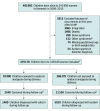Association of Labor Epidural Analgesia With Autism Spectrum Disorder in Children
- PMID: 34581738
- PMCID: PMC8479581
- DOI: 10.1001/jama.2021.12655
Association of Labor Epidural Analgesia With Autism Spectrum Disorder in Children
Abstract
Importance: A recent cohort study found that epidural analgesia during labor was associated with an increased risk of autism in offspring.
Objective: To investigate if labor epidural increases the risk of autism in offspring.
Design, setting, and participants: This nationwide retrospective cohort study identified all live-born children in Denmark between January 2006 and December 2013. Follow-up commenced at children's first birthday and ended in December 2017. Among 485 093 live-born children, 5915 were excluded because of occurrences during the first year of life including death, emigration, misregistration of birth, diagnosis of disease inherently linked to autism, or diagnosis of autism.
Exposures: Administration of epidural analgesia during labor, as identified by procedure code.
Main outcomes and measures: The main outcome of interest was incident diagnosis of autism spectrum disorder based on International Statistical Classification of Diseases and Related Health Problems, 10th Revision codes in the Danish Psychiatric Central Register or National Patient Register. Hazard ratios were estimated using Cox regression, adjusted for covariates describing maternal comorbidity, sociodemographic factors, lifestyle, pregnancy, psychiatric illness, psychotropic medication, medical-seeking behavior, and family history of autism. A secondary analysis used a within-mother design including only children of mothers with both exposure and nonexposure to labor epidural analgesia in different deliveries.
Results: The cohort included 479 178 children (233 405 girls [48.7%]; median maternal age at delivery, 30.9 [IQR, 27.6-34.2] years); of these, 92 900 (19.4%) were exposed to epidural analgesia during labor. Median follow-up was 7.0 years (IQR, 4.9-9.0 years), and by the end of follow-up, 6428 children (1.3%) had been diagnosed with autism. Exposed children had an autism diagnosis incidence rate of 23.1 per 10 000 person-years compared with 18.5 per 10 000 person-years in the unexposed group (crude hazard ratio, 1.29 [95% CI, 1.21-1.37]; adjusted hazard ratio, 1.05 [95% CI, 0.98-1.11]). A secondary within-mother analysis including 59 154 children (12.3%) estimated an autism diagnosis incidence rate of 20.8 per 10 000 person-years in the exposed group and 17.1 per 10 000 person-years in the unexposed group (adjusted hazard ratio, 1.05 [95% CI, 0.90-1.21]).
Conclusions and relevance: In this nationwide cohort study of Danish children, maternal exposure to epidural analgesia during labor was not significantly associated with autism spectrum disorder in offspring.
Conflict of interest statement
Figures


Comment in
-
Labor Epidural Analgesia and Autism Spectrum Disorder: Is There an Association?JAMA. 2021 Sep 28;326(12):1155-1157. doi: 10.1001/jama.2021.15369. JAMA. 2021. PMID: 34581752 Free PMC article. No abstract available.

